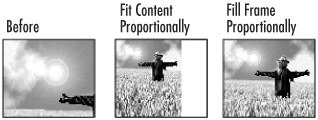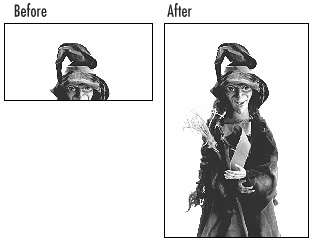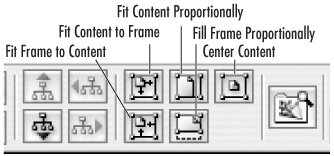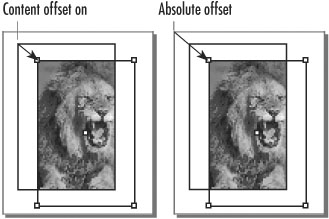| Placed images don't always fit perfectly into preexisting frames. InDesign gives you several commands that let you quickly position and resize artwork in frames. To resize the graphic to the frame size: 1. | Use either selection tool to select the frame or the graphic inside the frame.
| 2. | Choose Object > Fitting > Fit Content to Frame. This changes the size of the graphic to fit completely within the area of the frame  . .
 The effect of the Fit Content to Frame command. The effect of the Fit Content to Frame command.
 Tip This command does not preserve the proportions of the artwork; the artwork may become distorted. |
To proportionally resize to the frame size: 1. | Use either selection tool to select the frame or the graphic inside the frame.
| 2. | Choose Object > Fitting > Fit Content Proportionally. This changes the size of the graphic to fit completely, and without distortion, within the frame  . .
 The effect of the Fit Content Proportionally command. The effect of the Fit Content Proportionally command.
 Tip Use the Fit Frame to Content command (see the next page) to resize the frame to the size of the graphic. |
The Fit Content Proportionally command usually leaves some empty space between the graphic and the frame. What if you want to resize the image so that it fills the entire frame? That's where the Fill Frame Proportionally command comes to the rescue. To resize the graphic to fill the frame: 1. | Use either selection tool to select the frame or the graphic inside the frame.
| 2. | Choose Object > Fitting > Fill Frame Proportionally. This changes the size of the graphic to fit completely, and without distortion, within the frame  . .
 The Fit Content Proportionally command may leave a gap between the frame and the image. The Fill Frame Proportionally command always fills the frame. The Fit Content Proportionally command may leave a gap between the frame and the image. The Fill Frame Proportionally command always fills the frame.
 |
To resize the frame to the graphic size: 1. | Use either selection tool to select the frame or the graphic inside the frame.
| 2. | Choose Object > Fitting > Fit Frame to Content. This changes the size of the frame so that the artwork fits completely within the area of the frame  . .
 The effect of the Fit Frame to Content command. The effect of the Fit Frame to Content command.
 Tip The Fit Frame to Content command is also available for text frames. |
To center the graphic within the frame: 1. | Use either selection tool to select the frame or the graphic inside the frame.
| 2. | Choose Object > Fitting > Center Content. This centers the graphic within the frame without changing the size of either the graphic or the frame  . .
 The effect of the Center Content command. The effect of the Center Content command.
 Tip The Fitting commands are also available on the Control palette  . .
 Use the Fit icons in the Control palette to modify placed images and frames. Use the Fit icons in the Control palette to modify placed images and frames.
 |
In addition to the commands that position graphics, you can also position images numerically within frames using the X and Y coordinates in the Transform palette. To numerically position graphics within frames: 1. | Check Show Content Offset in the Transform palette menu.
| 2. | Use the Direct Selection tool to select the graphic inside the frame.
| 3. | Enter the X and Y coordinates in the Transform palette. The image moves to a new position relative to the frame  . This is called the content offset. . This is called the content offset.
 Content offset positions the graphic relative to the frame. Absolute offset positions the graphic relative to the page. Content offset positions the graphic relative to the frame. Absolute offset positions the graphic relative to the page.
 Tip Small plus signs (+) next to the X and Y coordinates in the Transform palette indicate that Show Content Offset is turned on  . .
 The plus signs (+) next to the X and Y coordinates indicate that the position of the object is relative to the frame. The plus signs (+) next to the X and Y coordinates indicate that the position of the object is relative to the frame.
 |
To numerically position graphics on the page: 1. | Uncheck Show Content Offset from the Transform palette menu.
| 2. | Use the Direct Selection tool to select the graphic inside the frame.
| 3. | Set the X and Y coordinates in the Transform palette. The image moves to a new position relative to the page rulers. This is called the absolute offset.
|
Of course you can use any of the transformation commands to scale, rotate, and shear objects within the frame. This allows you to scale images numerically within a frame. To transform images within a frame: 1. | Use the Direct Selection tool to select the graphic inside the frame.
| 2. | Use any of the transform tools or the Transform palette described on pages 91 100.
|
| 






